
views
Discovering When Your Hermit Crab is Molting
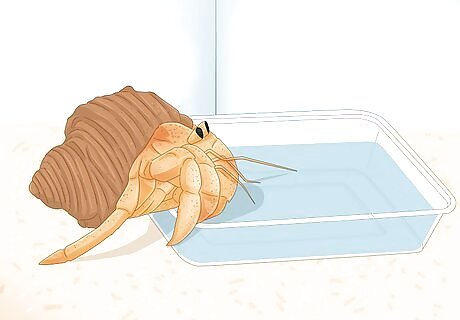
Track how much food and water your hermit crab consumes. Pre-molt hermit crabs consume more food and water in order to prepare for the time they will spend resting before and after their molt. In most cases, these crabs are below the substrate where they will not have access to their food and water. The excess food and water is stored in a molting sac where it can be accessed throughout the molt. Your crab will start consuming higher protein foods in preparation for molting as these foods offer higher energy. Regular and salt water are both essential to the molting process. The hermit crab uses water to create a barrier between the old and new exoskeleton, so they are able to safely break free. In addition to drinking more water, your crab may also soak in water or spill water onto the sand.

Watch for signs of excessive digging. They may be digging to find a safe place to molt, but excessive digging can also be a sign that the temperature or humidity are off. Check these levels. If they are at the right levels, your crab is more than likely digging to find a molting place.
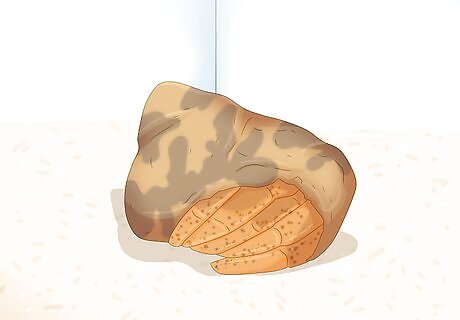
Note if your hermit crab is less active. Lethargy and lengthy periods of inactivity are normal leading up to a molt. The molting process is exhausting for your hermit crab, so he will likely rest before and after the process.

Look at your hermit crab for signs of molt. Crabs undergo a number of physical changes leading up to the molt, and recognizing these can be a helpful way to predict your hermit crab’s impending molt. Your crab may switch shells before a molt. Some switch to larger shells in preparation for a growth spurt. Others will switch into a smaller shell, which will make digging to safe level of the substrate easier. Exoskeletons may appear dull, ashy, chalky, or otherwise discolored. Toenails and hair, called setae, may appear stubby or worn down. Hermit crabs’ eyes may appear glassy or as if there is a film over them. Antennae begin to move more slowly, or in a confused pattern. If your crab has lost a limb, he may begin to regenerate limbs inside a gel-like chitin sack. Your crab may excrete a medicinal or ammonia-like scent.
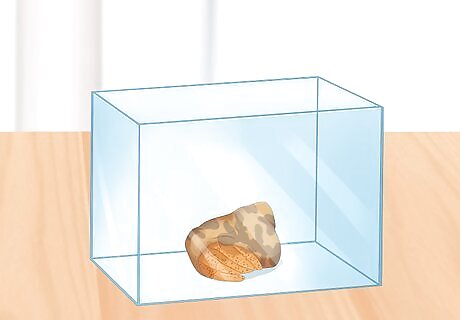
Isolate your hermit crab if you believe it is molting. As you learn the signs your crab is going to molt, it may be better to intervene early than to wait too long which could put your hermit crab in danger. If you notice your crab exhibiting one or more signs of molting, place it in an isolation tank for a few days or a week. If it doesn’t show continued signs of molting, it is safe to return it to the main tank. Otherwise, leave it safely isolated until after its molt.

Estimate the frequency and length of molting. You can predict how often your hermit crab will molt based on the size of the crab. A chart of average molting times will help you determine when to expect a molt. Micro or teeny hermit crabs, under .5 inches to 1 inch, can take 1 to 4 weeks to molt with only a month between. Small hermit crabs, 1 to 1.5 inches, will take 2 to 3 weeks every 1 to 3 months to complete their molt. Medium hermit crabs, 1.5 to 2 inches, need 3 to 6 weeks every 2 to 5 months to complete their molt. Large hermit crabs, 2 to 2.5 inches need 4 to 8 weeks every 4 to 10 months to complete their molt. Extra large hermit crabs, 2.5 to 3 inches, need 6 to 8 weeks every 10 to 12 months to complete their molt. Jumbo hermit crabs, 3 inches or more, need 8 to 16 weeks every 12 to 24 months to complete their molt.

Keep a molting journal. Adult hermit crabs usually molt once a year between May and September, but every crab is different. Keeping a journal of each of your crabs is a great way to begin predicting when their next molt will occur.
Keeping Your Hermit Crab Healthy During Annual Molting
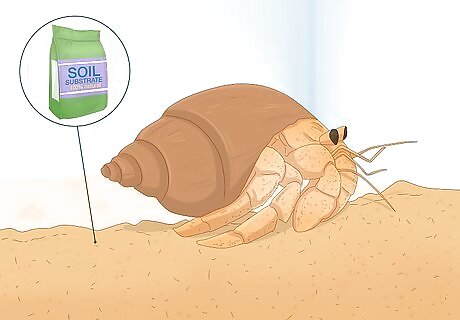
Set up your substrate for a molt. Use coconut fiber, play sand, or baked beach sand to create a substrate for your crabs. Your substrate should be six inches deep or at least three times deeper than the height of your largest crab. Keep the substrate at the optimal level of moisture by adding water one cup at a time and stirring it through the sand, until you’re able to create a hole in the sand without the sides caving in.
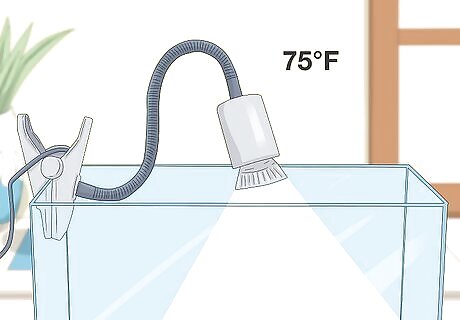
Maintain temperatures between 70 and 75 degrees Fahrenheit. Place a heater or heating lamp on one side of the tank. This allows your hermit crabs to move to a cooler temperature if they need to. Extended period of times above or below this temperature range can be detrimental to your crab’s health, causing them to freeze to death or dry out and suffocate.
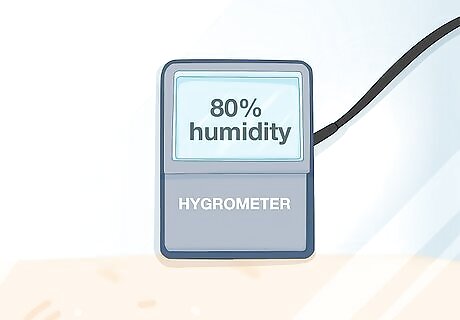
Keep tank humidity between 70 and 80%. This ensures the crab is moist and comfortable. Without enough humidity, your crab can suffocate, but with too much tank humidity, the crab can drown. It’s better to aim for lower humidity and provide your crab with a number of soaking pools that will allow them to add moisture whenever necessary. You can install a hygrometer to help you keep track of humidity in the tank.
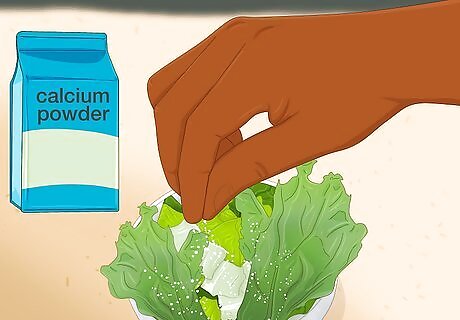
Feed your hermit crab high protein and high calcium foods. Before its molt, your crab needs these added nutrients. Protein gives the energy your hermit crab needs to undergo a molt. Calcium is a fundamental nutrient for growing a new exoskeleton. Feed your crab plenty of meat and nuts for protein prior to a molt. Shells, spinach, and shrimp all provide increased levels of calcium. Calcium supplements can be powdered and sprinkled over food.
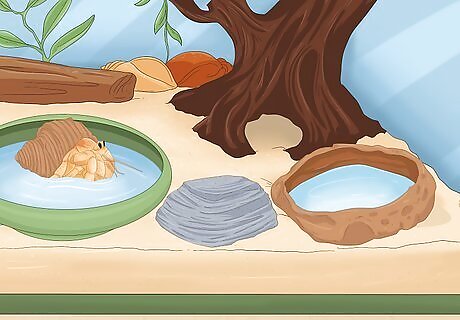
Give hermit crabs both regular and salt water in containers deep enough for crabs to submerge themselves, but not so deep they can’t get out. If you have a variety of sizes of crab, you may want to provide a bigger, deeper soaking pool with rocks, nets or other objects the smaller crabs can use to climb in and out.
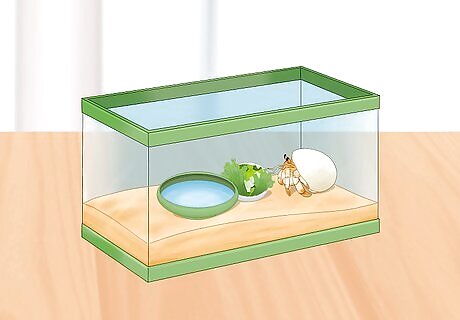
Isolate your crab in a separate tank. Set up another small tank with the proper temperature and humidity, as well as food and water. This tank does not need to be very large as the crab will not stay here for long. It should contain food, water, salt water, and enough substrate for your crab to dig down to protect itself.
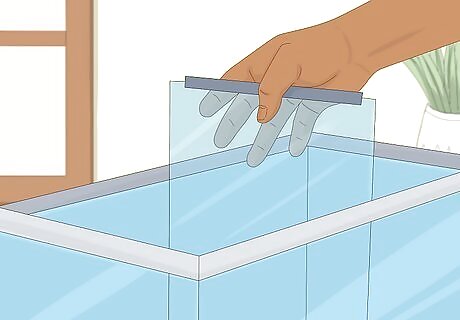
Protect your weakened hermit crab. If you do not isolate your hermit crab, it can get into fights with other crabs, the results of which may be injury or death. However, crabs molt safely in the wild with other hermit crabs nearby. If you’re unable to safely remove the crab before it begins to molt, there are a number of ways you can protect your hermit crab. Use a 2L plastic bottle to separate your crab. The bottle can be used to create a dome over the molting crab. Remove the lid to allow airflow for your crab. Push the bottle into the substrate over your crab all the way to the bottom of the tank, if possible. Place a divider in the tank that goes from the top all the way to the bottom, so your crabs cannot climb over or under the divider. If you’re unable to isolate the molting crab within the shared habitat, move non-molting crabs into a separate tank to limit stress for your molting crab.
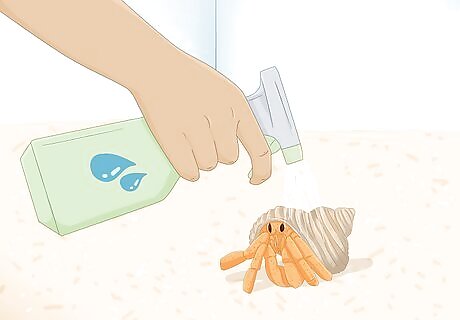
Mist the sand over the molting hermit crab. This provides the level of moisture necessary to complete a safe and healthy molt. One or two sprays a day will be plenty. Don’t oversaturate the substrate, but ensure your crab stays moisturized for optimal comfort.

Give your hermit crab privacy during its molt. Don’t dig up your crab, even if they’ve been underground for several weeks or a month. Make sure they’re isolated from other crabs, but don’t disturb them.
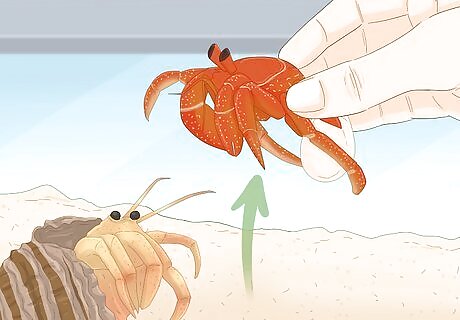
Keep your crab safe during surface molt. Most crabs will dig into the substrate before they molt, but if a molt occurs suddenly, they may not be able to protect themselves in time. When this occurs, it’s especially important to keep them safe and separated from other crabs. Try the bottle or divider method, but it may be best to simply remove the other crabs.
Caring for Your Hermit Crab After Molting
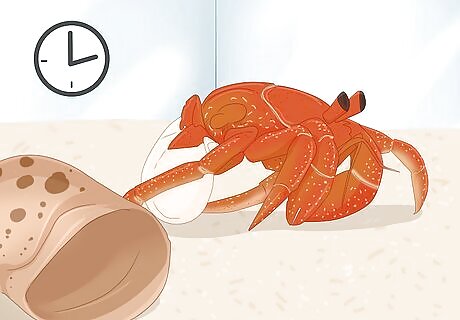
Allow your crab to molt at its own pace. Crabs can take up to three months to molt. Molting times vary from crab to crab, so if your hermit crab is still molting after the expected time, leave it be. It may seem disturbing, but even if your crab has died during the molt, it’s safer to leave the deceased hermit crab for several months, than to attempt to move a crab during its molt.
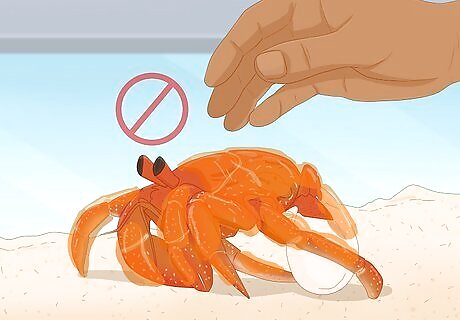
Protect the hermit crab while it is sensitive following a molt. Your crab will be sticky and soft following a molt. Never touch or mist a newly molted hermit crab as this can cause unintentional harm.
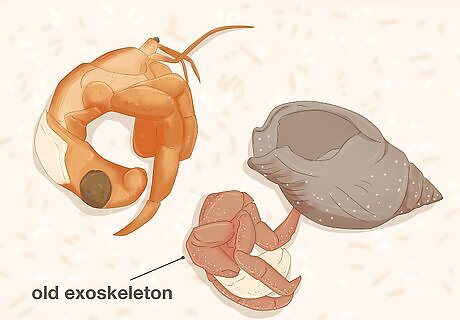
Save your crab’s old exoskeleton. Once your crab has broken free from its exoskeleton and has become mobile again, it will eat all or part of its shed exoskeleton in order to absorb the nutrients necessary to harden the new exoskeleton.
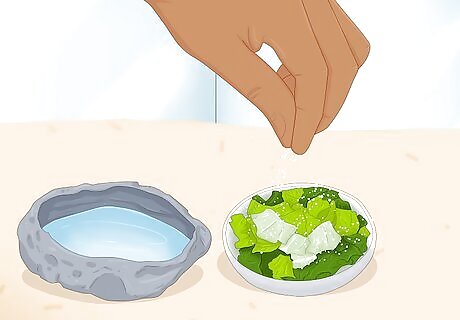
Provide the appropriate food and water. Your crab will also need a large quantity of foods high in protein and calcium supplements during this post-molt time, and you should have adequate amounts of unsalted and salt water available for your hermit crab to drink and soak in.
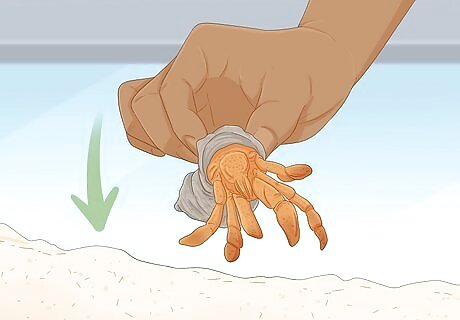
Return your hermit crab to the main tank. Once your hermit crab regains its full range of movement, and appears energetic, you can move it back to the main tank. You will need to closely observe the crab for several hours after returning it to the main tank looking for signs of concern. If the other hermit crabs exhibit aggressive behavior like crawling on top of the newly molted crab, you can place all the crabs in water to remove the molting scent. Your hermit crab may rebury itself in the main tank, and emerge at night to eat and drink. This is normal. Only re-isolate your crab if the other hermit crabs are bothering the spot where it’s buried.
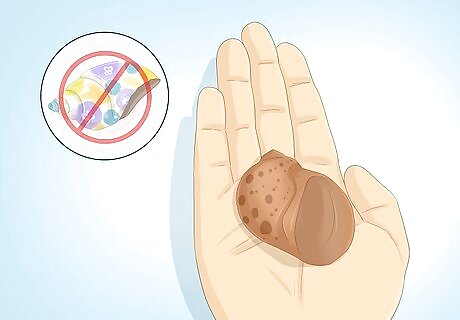
Offer a variety of shells. Do not offer shells that are broken or damaged. Your crab should have lots of options to ensure its comfort and reduce the risk for aggressive behavior between crabs. Boil shells to destroy any bacteria, prevent infection, and protect your crab. Try to provide natural shells. Avoid painted shells as your crab may accidentally ingest the paint. Your crab may simply go back into his old shell, and that’s okay too. Offering choices will improve your crab’s health and wellbeing as it guarantees they will be able to find a shell that fits comfortably.


















Comments
0 comment